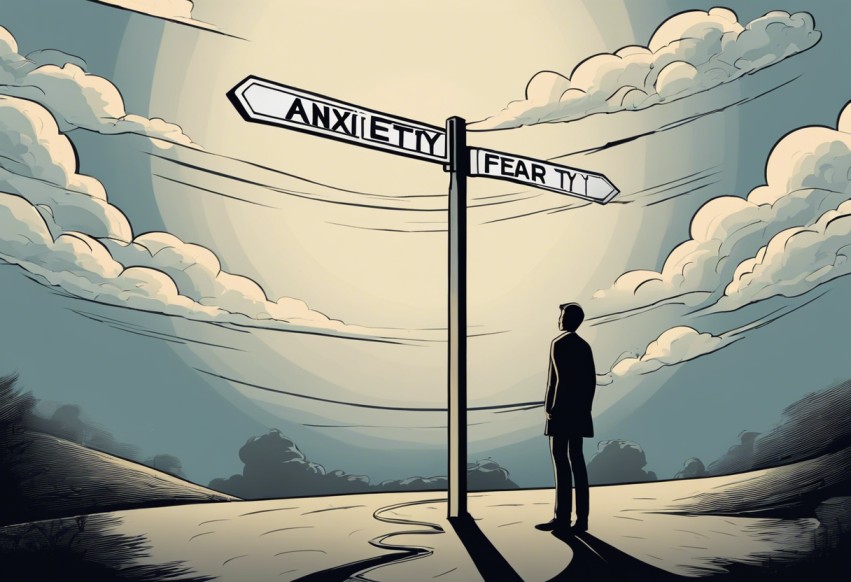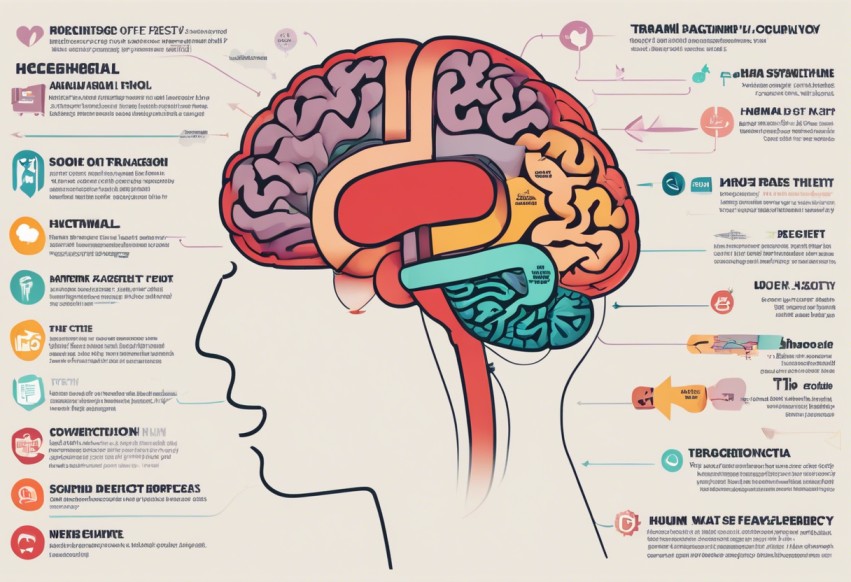Understanding Fear and Anxiety: A Comprehensive Guide

Table of Contents
Introduction: Defining Fear and Anxiety
Fear and anxiety are common emotions experienced by individuals and play significant roles in how we perceive and react to the world around us. To understand these complex emotions, it is crucial to define them accurately.
Defining Fear:
- Fear is a natural emotional response to a perceived threat or danger. It triggers our fight-or-flight response, preparing the body to either confront the threat or flee from it. Fear is often a temporary reaction to an immediate danger.
Defining Anxiety:
- Anxiety, on the other hand, is a prolonged and persistent feeling of worry, nervousness, or unease about something with an uncertain outcome. Unlike fear, anxiety is more generalized and not always linked to a specific threat.
Key Differences:
- Fear is usually short-lived and tied to a specific source of danger, while anxiety is a long-term state of apprehension and worry.
- Fear tends to fade once the threat is no longer present, whereas anxiety can persist even in the absence of an immediate threat.
- Fear is an emotional response to a known or clear danger, while anxiety can often be triggered by vague or unknown reasons.
Understanding the distinctions between fear and anxiety is essential for recognizing and managing these emotions effectively. Moving forward, this guide will delve deeper into the causes, symptoms, and strategies for coping with fear and anxiety to help individuals navigate these feelings in a healthier manner.
Understanding the Differences Between Fear and Anxiety

Fear and anxiety are common emotions experienced by people, but they are distinct in their characteristics and triggers. Here are key differences between them:
- Response to a Threat: Fear is a direct response to an immediate threat, whether real or perceived. It is often short-lived and is typically linked to a specific trigger. In contrast, anxiety is a more generalized feeling of apprehension or unease about potential future threats. It is more diffuse and can be triggered by various stressors or uncertainties.
- Duration: Fear tends to be temporary and is often resolved once the perceived threat is no longer present. On the other hand, anxiety can persist over a more extended period, even in the absence of an immediate threat. It can be ongoing and pervasive, impacting daily life and functioning.
- Physical Symptoms: Both of them can manifest physically, with symptoms like increased heart rate, rapid breathing, sweating, and tense muscles. However, fear’s physical symptoms are usually more intense and immediate, reflecting the body’s “fight or flight” response to a perceived danger. Anxiety symptoms may be more chronic and less intense but can still significantly impact a person’s well-being.
- Cognitive Factors: Fear is often accompanied by a sense of imminent danger, leading to a focused and immediate response to the perceived threat. In contrast, anxiety is characterized by excessive worry and rumination about potential future threats, which can lead to feelings of helplessness and uncertainty.
Understanding the differences between fear and anxiety can help individuals recognize and manage their emotions effectively. It is essential to seek support from mental health professionals if fear or anxiety significantly impacts quality of life and functioning.
The Physical and Psychological Effects of Fear and Anxiety

While crucial for survival, can have profound impacts on both the body and mind. Here are some of the physical and psychological effects to consider:
- Physical Effects:
- Trigger the body’s “fight or flight” response, leading to the release of stress hormones like adrenaline and cortisol.
- This response can result in physical symptoms such as increased heart rate, rapid breathing, muscle tension, and sweating.
- Prolonged fear and anxiety may weaken the immune system, making individuals more susceptible to illnesses.
- Chronic stress from them can lead to long-term health issues like high blood pressure, heart disease, and digestive problems.
- Psychological Effects:
- Can impair cognitive functions, affecting memory, concentration, and decision-making abilities.
- Individuals may experience uncontrollable worrying, restlessness, and irritability due to persistent fear and anxiety.
- Severe anxiety disorders can lead to panic attacks, phobias, and obsessive-compulsive behaviors that significantly interfere with daily life.
- Negative thought patterns fueled by them can contribute to the development of mood disorders like depression.
Understanding the physical and psychological effects of fear and anxiety is essential for managing and coping with these intense emotions. Seeking support from mental health professionals, practicing relaxation techniques, and engaging in regular physical activity can all help mitigate the impact of them on overall well-being.
Causes and Triggers of Fear and Anxiety

Fear and anxiety are complex emotions that can be triggered by various factors. Understanding the causes and triggers of these feelings is crucial in managing and overcoming them effectively.
- Biological Factors:
- Genetic predisposition can play a role in the development of fear and anxiety disorders. Abnormalities in brain structure or function, neurotransmitter imbalances, and hormonal changes can also contribute to these conditions.
- Traumatic Experiences:
- Past traumatic events such as accidents, abuse, or natural disasters can trigger fear and anxiety. Post-Traumatic Stress Disorder (PTSD) is a common condition that stems from such experiences.
- Stressful Situations:
- High levels of stress from work, relationships, or financial struggles can lead to feelings of fear and anxiety. Chronic stress can also weaken the body’s ability to cope with these emotions.
- Phobias and Fears:
- Specific phobias, such as fear of heights, spiders, or flying, can evoke intense feelings of fear and anxiety. These phobias are often irrational but can have a significant impact on daily life.
- Health Conditions:
- Certain medical conditions, such as heart problems, thyroid disorders, or respiratory issues, can manifest as symptoms of anxiety. It’s essential to address any underlying health issues that may be contributing to these emotions.
- Substance Abuse:
- Alcohol, drugs, or prescription medications can exacerbate feelings of fear and anxiety. Substance abuse can also lead to the development of anxiety disorders or panic attacks.
Understanding the various causes and triggers of fear and anxiety can help individuals identify and address the root of their emotional distress. By seeking appropriate support and implementing coping strategies, individuals can effectively manage these feelings and improve their overall well-being.
Coping Mechanisms for Managing Fear and Anxiety

Experiencing fear and anxiety is a common occurrence for many individuals. Fortunately, there are effective coping mechanisms that can help manage these overwhelming emotions. Here are some strategies to assist in dealing with fear and anxiety:
- Deep Breathing Exercises:
- Engaging in deep breathing exercises can help calm the mind and body during periods of intense fear or anxiety. Taking slow, deep breaths can regulate breathing patterns and promote relaxation.
- Mindfulness and Meditation:
- Practicing mindfulness techniques and meditation can help individuals focus on the present moment, reducing feelings of worry about the future or regrets about the past. Mindfulness can assist in acknowledging fears without allowing them to take over.
- Physical Activity:
- Engaging in regular physical activity, such as yoga, running, or other forms of exercise, can release endorphins and reduce stress levels. Physical activity is an effective way to channel nervous energy into a productive outlet.
- Seeking Support:
- Talking to a trusted friend, family member, or mental health professional can provide valuable support when dealing with fear and anxiety. Sharing feelings and experiences with others can offer comfort and perspective.
- Setting Boundaries:
- Establishing boundaries in personal and professional relationships can help reduce sources of stress and anxiety. Learning to say no to tasks or situations that cause excessive fear can be empowering.
Incorporating these coping mechanisms into daily routines can help individuals better manage fear and anxiety, leading to improved overall well-being and mental health.
The Role of Therapy and Medication in Treating Fear and Anxiety

Therapy and medication play crucial roles in treating fear and anxiety by offering effective strategies to manage symptoms and improve overall well-being. Here are some key points to consider:
- Therapy:
- Cognitive Behavioral Therapy (CBT): CBT is a widely used therapeutic approach that focuses on identifying and reframing negative thought patterns. Through CBT, individuals can learn coping mechanisms to challenge their fears and reduce anxiety levels.
- Exposure Therapy: This form of therapy involves gradually exposing individuals to the source of their fear in a controlled setting. Over time, this desensitization technique helps to decrease anxiety responses.
- Mindfulness-Based Therapy: Mindfulness practices can help individuals become more aware of their thoughts and emotions, allowing them to better manage anxiety triggers.
- Medication:
- Anti-Anxiety Medications: Medications such as benzodiazepines may be prescribed to help manage acute symptoms of anxiety. However, they are typically used for short-term relief due to the risk of dependence.
- Antidepressants: Selective serotonin reuptake inhibitors (SSRIs) and serotonin-norepinephrine reuptake inhibitors (SNRIs) are commonly prescribed to treat anxiety disorders. These medications help regulate neurotransmitters in the brain to improve mood and reduce anxiety symptoms.
In conclusion, a combination of therapy and medication can be highly effective in treating fear and anxiety. It is essential for individuals to work closely with mental health professionals to determine the most suitable treatment plan based on their unique needs and circumstances.
Exploring the Fine Line Between Rational Fear and Irrational Anxiety

- Anxiety is often distinguished from fear by its irrationality. While fear is a natural response to a real threat, anxiety tends to be disproportionate to the actual risk. This distinction is crucial in understanding the difference between the two.
- Rational fear serves a purpose in keeping individuals safe by alerting them to potential dangers. For example, fear of crossing a busy street without looking can prevent accidents. On the other hand, irrational anxiety can lead to excessive worrying about improbable scenarios, causing significant distress.
- Understanding the triggers of fear and anxiety is essential. Fear is typically triggered by specific stimuli or situations, such as a spider or heights, while anxiety can be more generalized and not necessarily tied to a particular threat.
- The physiological responses to fear and anxiety can be similar, including increased heart rate, sweating, and heightened alertness. However, fear tends to be more short-lived, triggered by an immediate threat, while anxiety can persist over time, even in the absence of a clear danger.
- Cognitive behavioral therapy (CBT) is often used to help individuals differentiate between rational fears and irrational anxieties. By challenging negative thought patterns and providing coping strategies, CBT can help individuals manage excessive anxiety and reduce the impact of irrational fears.
- Recognizing the fine line between rational fear and irrational anxiety is crucial for maintaining emotional well-being. By acknowledging and addressing irrational anxieties, individuals can learn to navigate their fears more effectively and lead a more balanced life.
Overcoming Fear and Anxiety through Mindfulness and Relaxation Techniques

Fear and anxiety can have a powerful grip on individuals, but there are effective ways to combat these negative emotions. Mindfulness and relaxation techniques offer practical strategies to help individuals navigate through fear and anxiety.
- Mindfulness: By practicing mindfulness, individuals can focus on the present moment without judgment. This can help reduce feelings of fear and anxiety by redirecting attention away from stressful thoughts. Mindfulness meditation, deep breathing exercises, and body scans are all effective techniques to cultivate mindfulness.
- Relaxation Techniques: Engaging in relaxation techniques can help calm the mind and body, making it easier to manage fear and anxiety. Progressive muscle relaxation, guided imagery, and visualization exercises can all promote relaxation and reduce feelings of tension and stress.
“Mindfulness allows individuals to observe their thoughts and emotions without becoming overwhelmed by them, providing a sense of control and clarity.”
“Relaxation techniques provide a toolbox of strategies to help individuals unwind and alleviate the physical and psychological symptoms of fear and anxiety.”
Incorporating mindfulness and relaxation techniques into a daily routine can have a significant impact on managing fear and anxiety. Consistent practice can help individuals develop resilience in the face of challenging situations and promote emotional well-being.
By prioritizing self-care and incorporating these techniques into their lives, individuals can work towards overcoming fear and anxiety and achieving a greater sense of peace and balance.
The Connection Between Fear, Anxiety, and Mental Health Disorders

Fear and anxiety play significant roles in the development and perpetuation of various mental health disorders. Understanding the connections between fear, anxiety, and these disorders is crucial for effective management and treatment. Here are key points to consider:
- Fear and Anxiety as Precursors: Fear and anxiety are natural responses to perceived threats or stressors. When these responses become chronic or overwhelming, they can contribute to the development of mental health disorders such as phobias, panic disorder, and generalized anxiety disorder.
- Neurobiological Factors: Fear and anxiety involve complex interactions within the brain and nervous system. Dysregulation in areas such as the amygdala, hippocampus, and prefrontal cortex can lead to heightened fear responses and increased anxiety, predisposing individuals to mental health disorders.
- Co-Occurrence with Disorders: Fear and anxiety often co-occur with other mental health disorders. For example, individuals with post-traumatic stress disorder (PTSD) may experience intense fear and anxiety related to past traumas, while those with depression may have heightened anxiety as a symptom.
- Impact on Symptom Severity: Fear and anxiety can exacerbate symptoms of existing mental health disorders. For instance, individuals with obsessive-compulsive disorder (OCD) may experience intensified anxiety when confronted with their obsessions, leading to increased compulsive behaviors.
- Treatment Implications: Addressing fear and anxiety is crucial in the treatment of mental health disorders. Therapeutic approaches such as cognitive-behavioral therapy (CBT), exposure therapy, and mindfulness techniques often target fear and anxiety to reduce symptom severity and improve overall mental well-being.
Understanding the intricate relationship between fear, anxiety, and mental health disorders is essential for clinicians, researchers, and individuals navigating these challenges. By addressing fear and anxiety effectively, it is possible to enhance treatment outcomes and promote mental health resilience.
Seeking Professional Help for Severe Fear and Anxiety

When fear and anxiety become overwhelming and start interfering with daily life, seeking professional help is paramount. Here are some important steps to consider for managing severe fear and anxiety effectively:
- Consulting a Mental Health Professional: It is essential to seek guidance from a mental health professional such as a psychologist, psychiatrist, or counselor. These experts are trained to diagnose and treat various anxiety disorders and can offer tailored treatment plans.
- Therapy Options: Cognitive-behavioral therapy (CBT) is a widely used and effective treatment for anxiety disorders. This type of therapy helps individuals identify and change negative thought patterns contributing to fear and anxiety.
- Medication: In some cases, medication might be prescribed to manage symptoms of severe anxiety. Antidepressants, anti-anxiety medications, or beta-blockers are commonly used to alleviate anxiety symptoms.
- Self-care Strategies: Alongside professional treatment, implementing self-care strategies can significantly help manage fear and anxiety. This can include regular exercise, proper sleep, healthy diet, mindfulness practices, and relaxation techniques.
- Support Groups: Joining a support group for individuals facing similar challenges can provide a sense of community and understanding. Sharing experiences and coping strategies with others can be comforting and empowering.
Remember, overcoming severe fear and anxiety is a journey that requires patience and commitment. Professional help can provide the necessary tools and support to navigate through challenging times and work towards managing fear and anxiety effectively.

